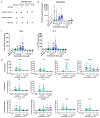Orientation of Antigen Display on Self-Assembling Protein Nanoparticles Influences Immunogenicity
- PMID: 33572803
- PMCID: PMC7911071
- DOI: 10.3390/vaccines9020103
Orientation of Antigen Display on Self-Assembling Protein Nanoparticles Influences Immunogenicity
Abstract
Self-assembling protein nanoparticles (SAPN) serve as a repetitive antigen delivery platform with high-density epitope display; however, antigen characteristics such as size and epitope presentation can influence the immunogenicity of the assembled particle and are aspects to consider for a rationally designed effective vaccine. Here, we characterize the folding and immunogenicity of heterogeneous antigen display by integrating (a) dual-stage antigen SAPN presenting the P. falciparum (Pf) merozoite surface protein 1 subunit, PfMSP119, and Pf cell-traversal protein for ookinetes and sporozoites, PfCelTOS, in addition to (b) a homogenous antigen SAPN displaying two copies of PfCelTOS. Mice and rabbits were utilized to evaluate antigen-specific humoral and cellular induction as well as functional antibodies via growth inhibition of the blood-stage parasite. We demonstrate that antigen orientation and folding influence the elicited immune response, and when appropriately designed, SAPN can serve as an adaptable platform for an effective multi-antigen display.
Keywords: PfCelTOS; PfMSP119; display; multi-stage; self-assembling protein nanoparticles; vaccine.
Conflict of interest statement
Peter Burkhard is the founder, co-owner, and CEO of Alpha-O Peptides AG, a company involved in nanoparticle vaccine design that holds intellectual property on the SAPN platform. The interpretations and opinions expressed herein belong to the authors and do not necessarily represent the official views of the U.S. Army, U.S. Navy, U.S. Department of Defense, or the U.S. government. Research was conducted in an AAALACi accredited facility in compliance with the Animal Welfare Act and other federal statutes and regulations relating to animals and experiments involving animals and adheres to principles stated in the Guide for the Care and Use of Laboratory Animals, NRC Publication, 2011 edition.
Figures





Similar articles
-
Combining Monophosphoryl Lipid A (MPL), CpG Oligodeoxynucleotide (ODN), and QS-21 Adjuvants Induces Strong and Persistent Functional Antibodies and T Cell Responses against Cell-Traversal Protein for Ookinetes and Sporozoites (CelTOS) of Plasmodium falciparum in BALB/c Mice.Infect Immun. 2019 May 21;87(6):e00911-18. doi: 10.1128/IAI.00911-18. Print 2019 Jun. Infect Immun. 2019. PMID: 30936155 Free PMC article.
-
Analysis of genetic diversity and population structure of gene encoding cell-traversal protein for ookinetes and sporozoites (CelTOS) vaccine candidate antigen in global Plasmodium falciparum populations.Infect Genet Evol. 2018 Apr;59:113-125. doi: 10.1016/j.meegid.2018.01.023. Epub 2018 Jan 31. Infect Genet Evol. 2018. PMID: 29391203
-
Conformation-specific display of 4E10 and 2F5 epitopes on self-assembling protein nanoparticles as a potential HIV vaccine.Chem Biol Drug Des. 2012 Sep;80(3):349-57. doi: 10.1111/j.1747-0285.2012.01423.x. Epub 2012 Jul 3. Chem Biol Drug Des. 2012. PMID: 22650354
-
Self-Assembling Protein Nanoparticles: implications for HIV-1 vaccine development.Nanomedicine (Lond). 2018 Sep;13(17):2121-2125. doi: 10.2217/nnm-2018-0222. Epub 2018 Oct 1. Nanomedicine (Lond). 2018. PMID: 30270731 Review. No abstract available.
-
Towards an RTS,S-based, multi-stage, multi-antigen vaccine against falciparum malaria: progress at the Walter Reed Army Institute of Research.Vaccine. 2005 Mar 18;23(17-18):2243-50. doi: 10.1016/j.vaccine.2005.01.142. Vaccine. 2005. PMID: 15755604 Review.
Cited by
-
Effects of Germination on the Structure, Functional Properties, and In Vitro Digestibility of a Black Bean (Glycine max (L.) Merr.) Protein Isolate.Foods. 2024 Feb 3;13(3):488. doi: 10.3390/foods13030488. Foods. 2024. PMID: 38338623 Free PMC article.
-
Chemical and biological conjugation strategies for the development of multivalent protein vaccine nanoparticles.Biopolymers. 2023 Aug;114(8):e23563. doi: 10.1002/bip.23563. Epub 2023 Jul 25. Biopolymers. 2023. PMID: 37490564 Free PMC article. Review.
-
Optimized Refolding Buffers Oriented Humoral Immune Responses Versus PfGCS1 Self-Assembled Peptide Nanoparticle.Mol Biotechnol. 2024 Sep;66(9):2648-2664. doi: 10.1007/s12033-023-01044-y. Epub 2024 Jan 24. Mol Biotechnol. 2024. PMID: 38267696
-
Exploring in vitro expression and immune potency in mice using mRNA encoding the Plasmodium falciparum malaria antigen, CelTOS.Front Immunol. 2022 Dec 15;13:1026052. doi: 10.3389/fimmu.2022.1026052. eCollection 2022. Front Immunol. 2022. PMID: 36591298 Free PMC article.
-
Systems biology of malaria explored with nonhuman primates.Malar J. 2022 Jun 7;21(1):177. doi: 10.1186/s12936-022-04199-2. Malar J. 2022. PMID: 35672852 Free PMC article. Review.
References
-
- WHO . World Malaria Report 2020. World Health Organization; Geneva, Switzerland: 2020.
-
- Weiss D.J., Lucas T.C.D., Nguyen M., Nandi A.K., Bisanzio D., Battle K.E., Cameron E., Twohig K.A., Pfeffer D.A., Rozier J.A., et al. Mapping the global prevalence, incidence, and mortality of Plasmodium falciparum, 2000–2017: A spatial and temporal modelling study. Lancet. 2019;394:322–331. doi: 10.1016/S0140-6736(19)31097-9. - DOI - PMC - PubMed
-
- Zinszer K., Charland K., Vahey S., Jahagirdar D., Rek J.C., Arinaitwe E., Nankabirwa J., Morrison K., Sadoine M.L., Tutt-Guerette M.A., et al. The Impact of Multiple Rounds of Indoor Residual Spraying on Malaria Incidence and Hemoglobin Levels in a High-Transmission Setting. J. Infect. Dis. 2020;221:304–312. doi: 10.1093/infdis/jiz453. - DOI - PMC - PubMed
-
- Kenangalem E., Poespoprodjo J.R., Douglas N.M., Burdam F.H., Gdeumana K., Chalfein F., Prayoga, Thio F., Devine A., Marfurt J., et al. Malaria morbidity and mortality following introduction of a universal policy of artemisinin-based treatment for malaria in Papua, Indonesia: A longitudinal surveillance study. PLoS Med. 2019;16:e1002815. doi: 10.1371/journal.pmed.1002815. - DOI - PMC - PubMed
LinkOut - more resources
Full Text Sources
Other Literature Sources
Research Materials

